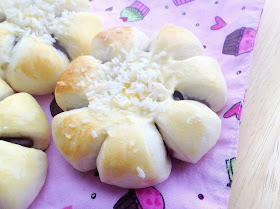My house smelled like an asian bakery today, what a wonderful smell it was.The dough used to make these buns is the same dough used for at least half the little bread snacks you find in a typical Asian bakery. It is a super soft, puffy/airy (similar to puff pastry but softer like a roll), sweet and fragrant bread. What came out of my kitchen today was spot on. Happy happy day for me! I love asian bakeries and now I can start recreating the numerous tasty munchies I used to frequently indulge in when I lived in Taiwan and Beijing. Yay! They have been missed much.
Asians get so creative in their bakeries, I have never seen anything like it in the west. You walk up and down rows and rows of shelves holding seemingly endless varieties of sweet and savory snack breads. My favorite snack bread I got often in Taiwan had a dip in the center that was filled with sweetened cream cheese and then a layer of blueberry pie filling. Yum! I already have so many future plans for this dough.
I buy adzuki beans at a store called The Bulk Barn so even if you don't have an asian market in your area try a store selling bulk foods.
My kids love these! They love to pull the petals off one by one and eat them. Perfect size bites.
IngredientsMy kids love these! They love to pull the petals off one by one and eat them. Perfect size bites.
My husband and I love to have friends over to play board games with us. We have several gaming groups that we get together with regularly. We also love to cook up lots of fun party food for these occasions. We served these to two of our gaming buddies who had never had Asian red bean paste before and they loved them!
1 recipe Hokkaido Milk Bread dough
1 recipe red bean paste (already prepared and chilled)
紅豆Red Bean Filling:
Recipe from Chinese Snacks Revised by Huang Su Huei
This method produces a really smooth silky bean paste which is my preference. If you like your red bean paste chunky omit the straining and cheese cloth step.
1 3/4 cups sugar
3/4 cup real butter
Rinse and soak adzuiki beans in water overnight (or, immerse in cold water, bring to a boil, turnoff heat and soak 1 hour). Drain and discard water. Add 8 cups of water to beans and cover and bring to a boil. Reduce heat to medium and cook 1 1/2 hours until beans are soft. Strain the beans, pushing the beans through a fine mesh, discard the skins.
Place the strained beans in a cheese cloth bag and squeeze to get out excess moisture. Put the strained beans, butter and sugar in a pan and cook until almost all the water has evaporated stirring the beans continuously so they stick to on the bottom of the pan . After refrigerating the bean paste several hours or overnight, or until firm enough to form into balls。
Making the Dough
Prepare the Hokkaido Milk Bread dough and allow to rest until double in size.
Forming the Buns
Once the milk bread dough has doubled in size divide it into 2 ounce portions (about 18 pieces) and form into balls.
Next roll filling into 1 Tbsp. size balls. Form a piece of dough into a bowl and place filling inside.
Push the filling down and pull the side of dough up around the filling.
Pinch the top closed, this then becomes the bottom of the bun.

Flatten the balls to about 1 inch thick. This is an important step as it flattens out the bean paste making a thin even layer throughout the center of the bun.
Allow to rest 40 minutes or up to 1 hour or until puffed.
Make an indentation in the center. You can leave it plan or fill the indentation with sweetened cream cheese or custard (I love it this way!)
Brush egg yolk.
Sprinkle a generous amount of sweetened shredded coconut in the center.
Bake in a 355 F oven for 10 minutes. Then turn off the oven, without opening the door and set the timer for another 5 minutes. When the timer beeps remove it from the oven immediately.Warning: It is super important that you follow both the weight (2 oz.) of dough for each bun and the cooking time. This dough needs a very specific cooking time per weight because the buns will be dry if overcooked in the slightest. Don't worry if they are not as browned as you like, it is more important that they are not overcooked. The egg yolk is brushed on to help with browning for an appealing appearance. It also helps to rotate the pan half way through cooking for more even browning.
These picture don't do justice to just how airy and moist these buns are.
You will just have to make them and find out yourself. These are sooo addictive!



















No comments:
Post a Comment